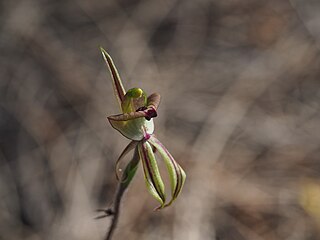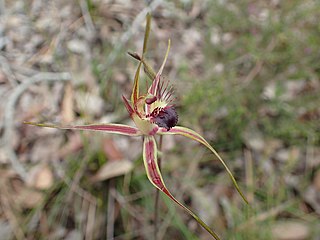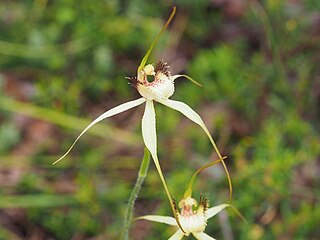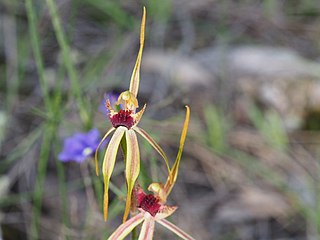
Caladenia paludosa, commonly known as the swamp spider orchid, is a species of orchid endemic to the south-west of Western Australia. It has a single erect, hairy leaf and up to three red, greenish-yellow and cream-coloured flowers. It mostly grows in dense scrub and is one of the last of the similar spider orchids to flower.

Caladenia plicata, commonly known as the crab-lipped spider orchid, is a species of orchid endemic to the south-west of Western Australia. It has a single hairy leaf and one or two red, yellow and pale green flowers with an unusual labellum which vibrates in the slightest breeze.

Caladenia crebra, commonly known as the Arrowsmith spider orchid is a species of orchid endemic to the south-west of Western Australia. It has one or two relatively large, greenish-yellow flowers whose lateral sepals have thin brown "clubs" on their ends.

Caladenia arrecta, commonly known as the reaching spider orchid, is a plant in the orchid family Orchidaceae and is endemic to the south-west of Western Australia. It has a single erect, hairy leaf and up to three red, yellow and green flowers on a flowering stem up to 35 cm (10 in) high. It is distinguished from the similar C. longiclavata and C. magniclavata by its upswept petals and distinctive calli. Although not common, it is widespread in south-eastern coastal areas.

Caladenia brevisura, commonly known as the short-sepalled spider orchid, is a plant in the orchid family Orchidaceae and is endemic to the south-west of Western Australia. It is a common, small-flowered orchid with an erect, hairy leaf and a single greenish flower with red markings, on a flowering stem up to 25 cm (10 in) high. It is found between Ravensthorpe and Israelite Bay.

Caladenia brownii, commonly known as the karri spider orchid, is a plant in the orchid family Orchidaceae and is endemic to the south-west of Western Australia. It has an erect, hairy leaf and up to three flowers which are a combination of red, green, white and yellow. It is found in the high rainfall forests and coastal heath of the far south-west corner of Western Australia and is the only caladenia to grow in karri forest.

Caladenia busselliana, commonly known as Bussell's spider orchid, is a plant in the orchid family Orchidaceae and is endemic to a small area in the south-west of Western Australia. It is a rare orchid with an erect, hairy leaf and up to three pale yellow flowers. Only about fifty specimens are known and it is threatened by habitat destruction and by too-frequent or too infrequent bushfires.
Caladenia cristata, commonly known as the crested clown orchid or crested spider orchid is a species of orchid endemic to a small area in the south-west of Western Australia. It has a single hairy leaf and a greenish-yellow and red flower on an unusually tall spike, considering the small size of the flower. Since its discovery in 1923 and collections made in 1923 it was thought to be extinct, until rediscovered in 1986.

Caladenia denticulata subsp. denticulata, commonly known as the yellow spider orchid, is a plant in the orchid family Orchidaceae and is endemic to the south-west of Western Australia. It has a single erect, hairy leaf and one or two yellowish flowers which have a white labellum with pale red markings.

Caladenia doutchiae, commonly known as the purple-veined clown orchid or purple-veined spider orchid is a species of orchid endemic to the south-west of Western Australia. It has a single hairy leaf and usually only one greenish-yellow and red flower with short, downswept petals, and lateral sepals that are broad at the base then narrow to a glandular tip.
Caladenia graniticola, commonly known as the Pingaring spider orchid, is a species of orchid endemic to the south-west of Western Australia. It has a single, hairy leaf and one or two yellowish-green, red and white flowers which have a greenish-yellow and white labellum with a red tip. It was originally described as Caladenia hoffmanii subsp. graniticola but has a slightly different labellum and column.
Caladenia hoffmanii, commonly known as Hoffman's spider orchid is a species of orchid endemic to the south-west of Western Australia. It has a single, hairy leaf and one or two, greenish-yellow, red and white flowers which have a greenish-yellow labellum with a red tip. It is distinguished from the Pingaring spider orchid by small differences in the labellum and more northerly distribution.

Caladenia infundibularis, commonly known as the funnel-web spider orchid is a species of orchid endemic to the south-west of Western Australia. It has a single hairy leaf and up to three greenish-yellow flowers which have a red-tipped labellum.

Caladenia longiclavata, commonly known as the clubbed spider orchid is a species of plant in the orchid family, Orchidaceae and is endemic to the south-west of Western Australia. It is a widespread and common orchid with a single, hairy leaf and one or two greenish-yellow, white and red flowers and which grows in the area between Perth and Albany.

Caladenia magniclavata, commonly known as the big clubbed spider orchid is a species of orchid endemic to the south-west of Western Australia. It has a single, hairy leaf and up to three pale yellow-green and red flowers with downswept, prominently clubbed sepals and petals.

Caladenia multiclavia, commonly known as the lazy spider orchid is a species of orchid, endemic to the south-west of Western Australia. It has a single, hairy leaf and one or two greenish-yellow, red and cream-coloured flowers resembling a reclining spider. Although it usually only has a single flower, it often grows in clumps of up to six plants.

Caladenia procera, commonly known as the Carbunup king spider orchid, is a species of orchid endemic to the south-west of Western Australia. It has a single erect, hairy leaf and up to four greenish-yellow and red flowers. It is one of the tallest and has amongst the largest flowers of the spider orchids.

Caladenia thinicola, commonly known as the Scott River spider orchid, is a species of orchid endemic to the south-west of Western Australia. It has a single erect, hairy leaf and up to four yellowish-green and red flowers with a fringe of long teeth on the sides of the labellum and thick brown, club-like glandular tips on the sepals.

Caladenia uliginosa subsp. uliginosa, commonly known as the dainty spider orchid, or darting spider orchid is a plant in the orchid family Orchidaceae and is endemic to the south-west of Western Australia. It has a single hairy leaf and up to four greenish-cream flowers which have a forward-projecting labellum with a dark red tip.

Caladenia williamsiae, commonly known as Judy's spider orchid, or Williams' spider orchid is a species of orchid endemic to the south-west of Western Australia. It is a rare species with a single relatively large, erect, hairy leaf and one or two delicate, greenish-yellow and red flowers. It is only known from a single population near Brookton.

















